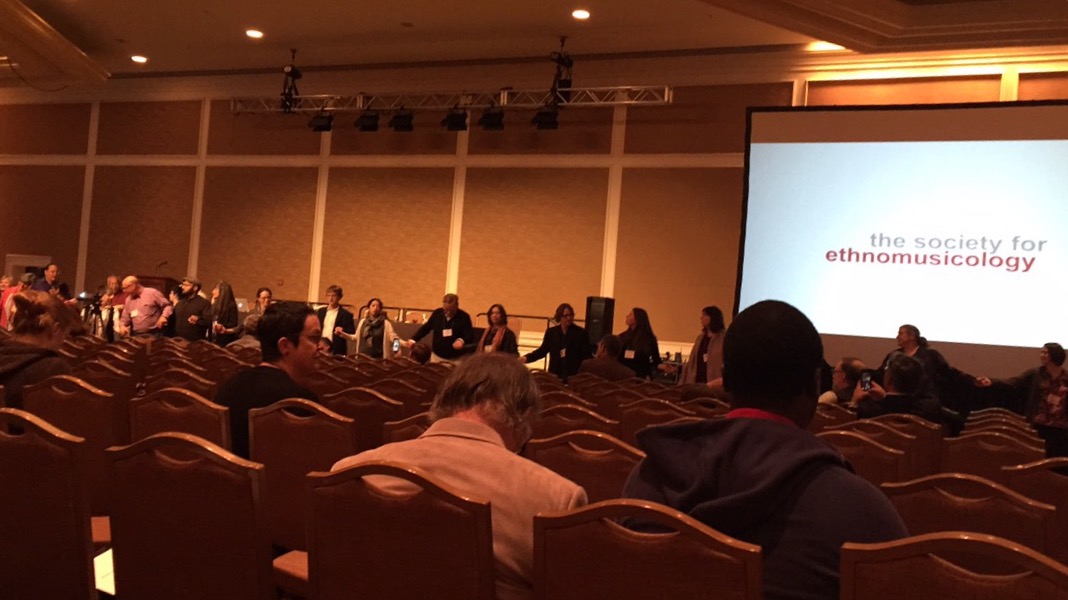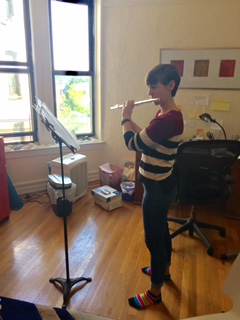We played the tambin today! The tambin is a type of transverse flute from Guinea. The ones we played were diatonic, while many related flutes are pentatonic. There are a few main differences between the western flute and the tambin that alter the overall sound. The tone hole of the tambin is quite large and is square shaped. On traditional instruments, there are three holes, spaced somewhat far apart, covered by your left hand ring finger, right hand pointer finger, and right hand ring finger. Use of harmonics provides the pitches. Also pretty nifty, you can play the tambin either to the right or left – whatever floats your boat!
Sylvain Leroux, the tambin player that was working with us, brought a variety of tambin sizes, which means the modes each played also differed. Phrygian mode was common though. One of the main sonic aspects of the timban is its reliance on multiphonics and the “chuff” of the sound; this is very different than the pure sound we often strive for on western flutes. Typically the low register is not played on the tambin (though it is available), and the style of playing is upbeat/quick. Additionally, singing while playing, or even singing in between playing, is common.
Related to the singing and playing, Sylvain demonstrated that this technique of singing certain pitches to highlight the line works well even in traditional western music. He played some Bach as an example. We also listened to a recording of Sylvain’s mentor, Bailo Bah, playing that employed the interspersed singing technique. He was rockin’.
The coolest thing to me is that you can adapt the western flute to mimic a tambin! If you remove the footjoint and use the fingerings for D, F, and A, you essentially have a makeshift tambin! How awesome is that???
Other things:
- Robert encouraged us to question fundamental assumptions with flute playing to discover new things.
- I’ve been playing piccolo A LOT these past few days. Switching from bass flute to piccolo is really an experience.
Sylvain Leroux, the tambin player that was working with us, brought a variety of tambin sizes, which means the modes each played also differed. Phrygian mode was common though. One of the main sonic aspects of the timban is its reliance on multiphonics and the “chuff” of the sound; this is very different than the pure sound we often strive for on western flutes. Typically the low register is not played on the tambin (though it is available), and the style of playing is upbeat/quick. Additionally, singing while playing, or even singing in between playing, is common.
Related to the singing and playing, Sylvain demonstrated that this technique of singing certain pitches to highlight the line works well even in traditional western music. He played some Bach as an example. We also listened to a recording of Sylvain’s mentor, Bailo Bah, playing that employed the interspersed singing technique. He was rockin’.
The coolest thing to me is that you can adapt the western flute to mimic a tambin! If you remove the footjoint and use the fingerings for D, F, and A, you essentially have a makeshift tambin! How awesome is that???
Other things:
- Robert encouraged us to question fundamental assumptions with flute playing to discover new things.
- I’ve been playing piccolo A LOT these past few days. Switching from bass flute to piccolo is really an experience.
This is a tiny part of the Kate Soper piece Only the Words Themselves Mean What They Say for flutist and soprano.
(Come to our recital December 11 for the entire piece!)
(Come to our recital December 11 for the entire piece!)
- I went to the Japanese place Sake Bar Hagi with a friend; it was delicious! I don’t remember the names of the food we ate, but it was tasty. I also tried a plum sour vodka drink, and it was pleasant too
- I’m about to fly to Michigan for the wedding of one of my best friends! Can’t wait!
- I bought a plane ticket to return to Texas!!!!
Until next time!
- I’m about to fly to Michigan for the wedding of one of my best friends! Can’t wait!
- I bought a plane ticket to return to Texas!!!!
Until next time!



